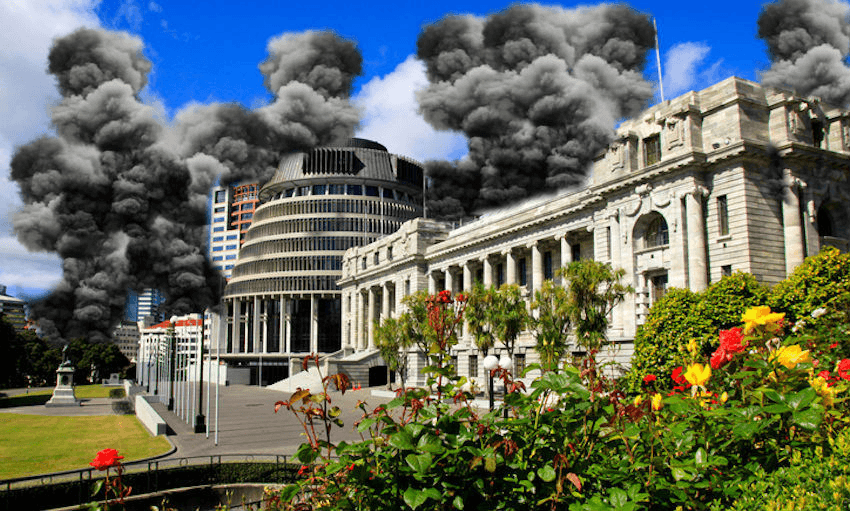Extinction Rebellion takes a tour of downtown Wellington to point out the coal industry stalwarts and ask why they’re still there in the face of a climate emergency.
“There are coal companies in Wellington??”
That’s the incredulous response every single time we mention taking the public on a tour of the biggest coal industry companies and supporters in Wellington.
Yes, appallingly, there are. Right here in our beautiful, progressive, kākā-filled coolest little capital. While we enjoy our green belt and harbour views, Wellington-based coal advocates and companies are responsible for expanding coal mining in the Waikato, Canterbury, Southland and on the South Island’s West Coast, devastating the local ecosystems and spewing further CO2 into the atmosphere when we are already in a climate and ecological emergency. So, the local Extinction Rebellion group hosted a tour of four of the biggest baddies, highlighting Welly’s less promotional title of the “coalest little capital”.
First up, right there on Willeston Street, is the head office of the biggest coal company in the country, Bathurst Resources. Bathurst started as a small Australian company before deciding to cross the Tasman in search of easier pickings. They scratched around to little effect before partnering with fishing company Talleys, which presumably concluded that its environmental reputation couldn’t get any worse anyway. They formed BT Mining and bought up the mines of former state-owned coal miner Solid Energy at bargain-basement prices when that company went bust.
Between them, Bathurst and BT Mining mined over two million tonnes of coal from New Zealand soil in 2017, leading to an estimated four million tonnes of greenhouse gas emissions that our planet’s overheated atmosphere does not need. Bathurst’s reckless destruction of the beautiful, biodiverse Denniston plateau also shows its contempt for anything other than profit.
Coal consumer Fonterra, New Zealand’s biggest greenhouse gas emitter, has its Wellington headquarters on Lambton Quay. Most of Fonterra’s emissions come from its on-farm activities, driven by its relentless, reckless programme of dairy intensification that has left farmers in hock to predatory banks, and rivers, lakes and landscapes ruined throughout the country. In addition, Fonterra uses fossil fuels for most of its milk-drying. In 2017, the dairy co-operative reported that it had burned 500,000 tonnes of coal leading to 837,000 tonnes of CO2 emissions.
Fonterra is moving to replace burning coal for heat, instead using electricity and burning biomass from sustainable sources, such as wood waste – but its progress is nowhere near fast enough relative to the scale of the climate emergency we face.
Next there is Straterra the mining lobbyist on the Terrace, whose sole purpose is to promote mining. Within Straterra nestles the Coal Association of New Zealand, chaired by the CEO of Bathurst Resources. They have no intention whatsoever to phase out coal. Indeed all their plans rely on the assumption that some magical technology will be discovered that will allow them to keep expanding coal mining forever. Spoiler: it isn’t going to happen.
Even the Ministry of Business, Innovation and Employment has a department called NZ Petroleum and Minerals (NZPAM), whose taxpayer-funded staff spend their days promoting mining – so explicitly that it’s hard to distinguish NZPAM’s work from industry lobbyists Straterra.
NZPAM oversees legislation in the Crown Minerals Act that specifically states its purpose as “to promote prospecting for, exploration for, and mining of Crown-owned minerals” – including coal. Government departments should be managing the end of coal in New Zealand and ensuring a just transition away from fossil fuels. Instead, NZPAM acts as cheerleaders and enablers for this deadly industry.
At this point, the need to phase out coal is obvious. The wreckage of habitats and local air and water pollution from coal mining are reason enough, before even factoring in the climate emergency. And the key point is: we don’t need it. Coal is on the way out – for heat production, for energy generation, and even for steel production. Fossil-free production processes are now being scaled up to commercial levels, and much more could be done with recycling steel and with wood-based construction that has the added benefit of sequestering carbon.
These coal advocates have had a free rein for too long. That era is over.
Melanie Vautier and Tim Jones are climate change activists and members of Extinction Rebellion.

